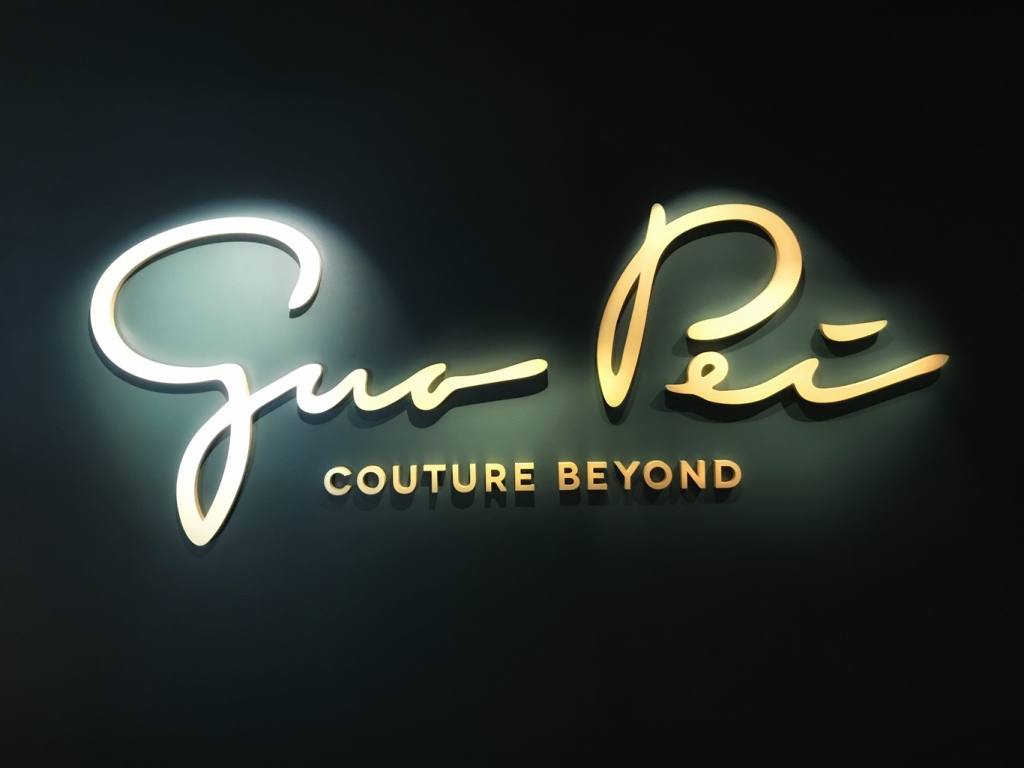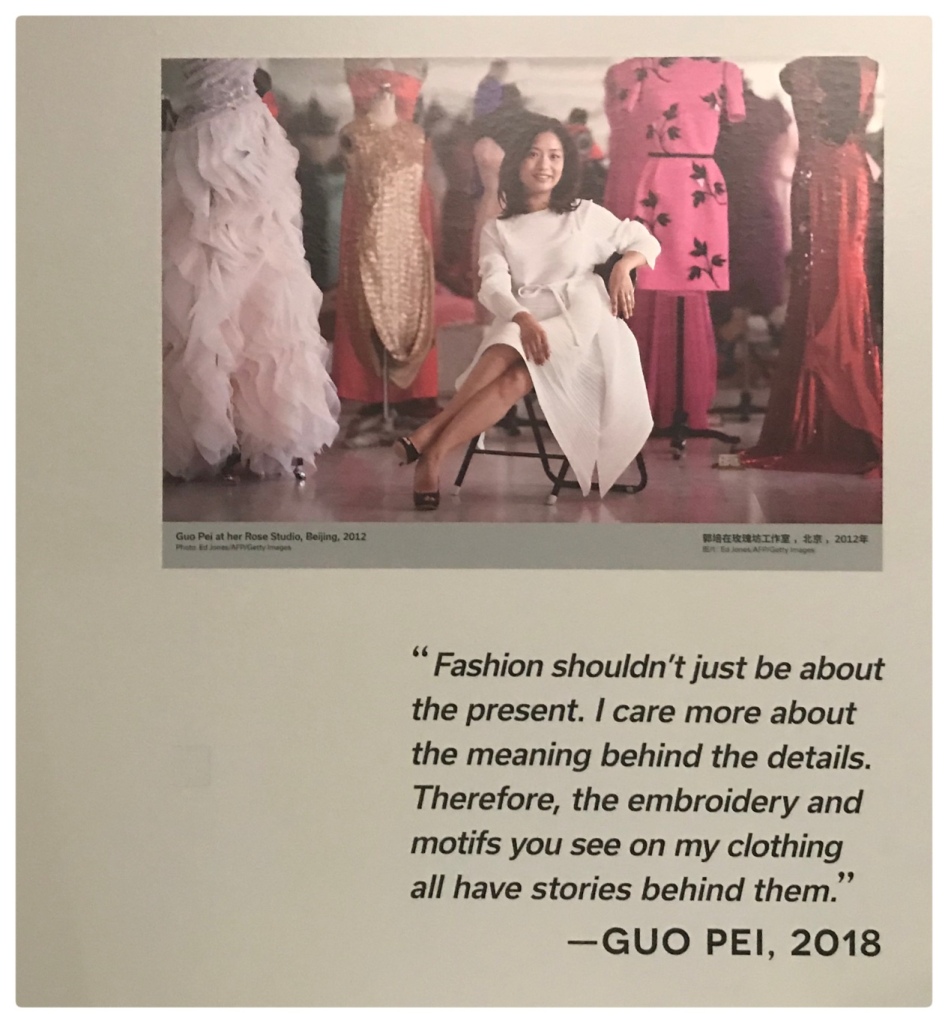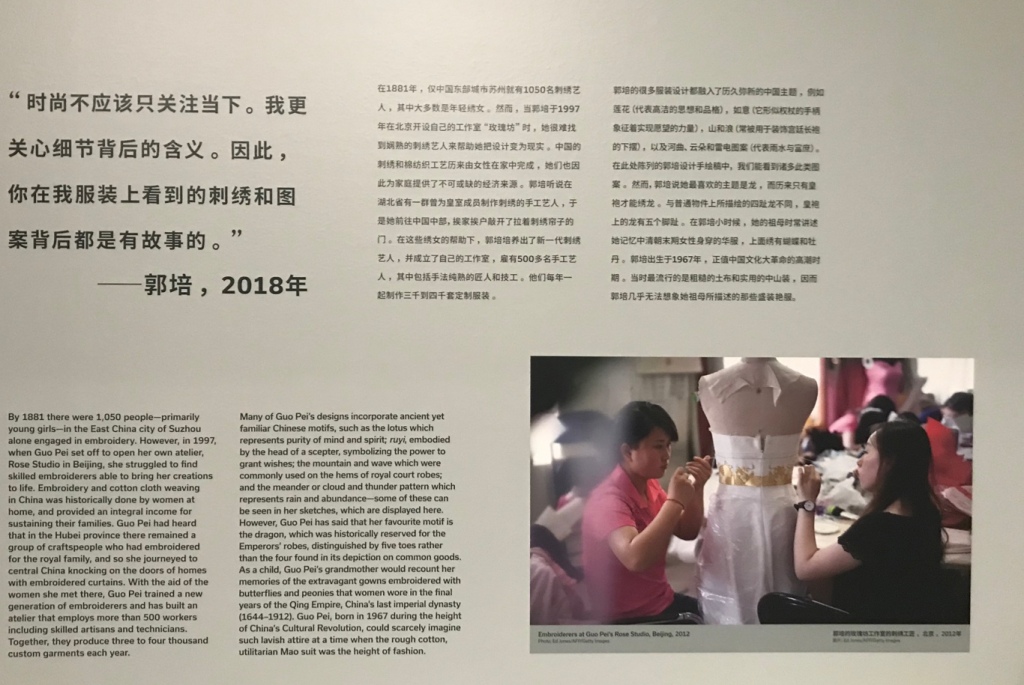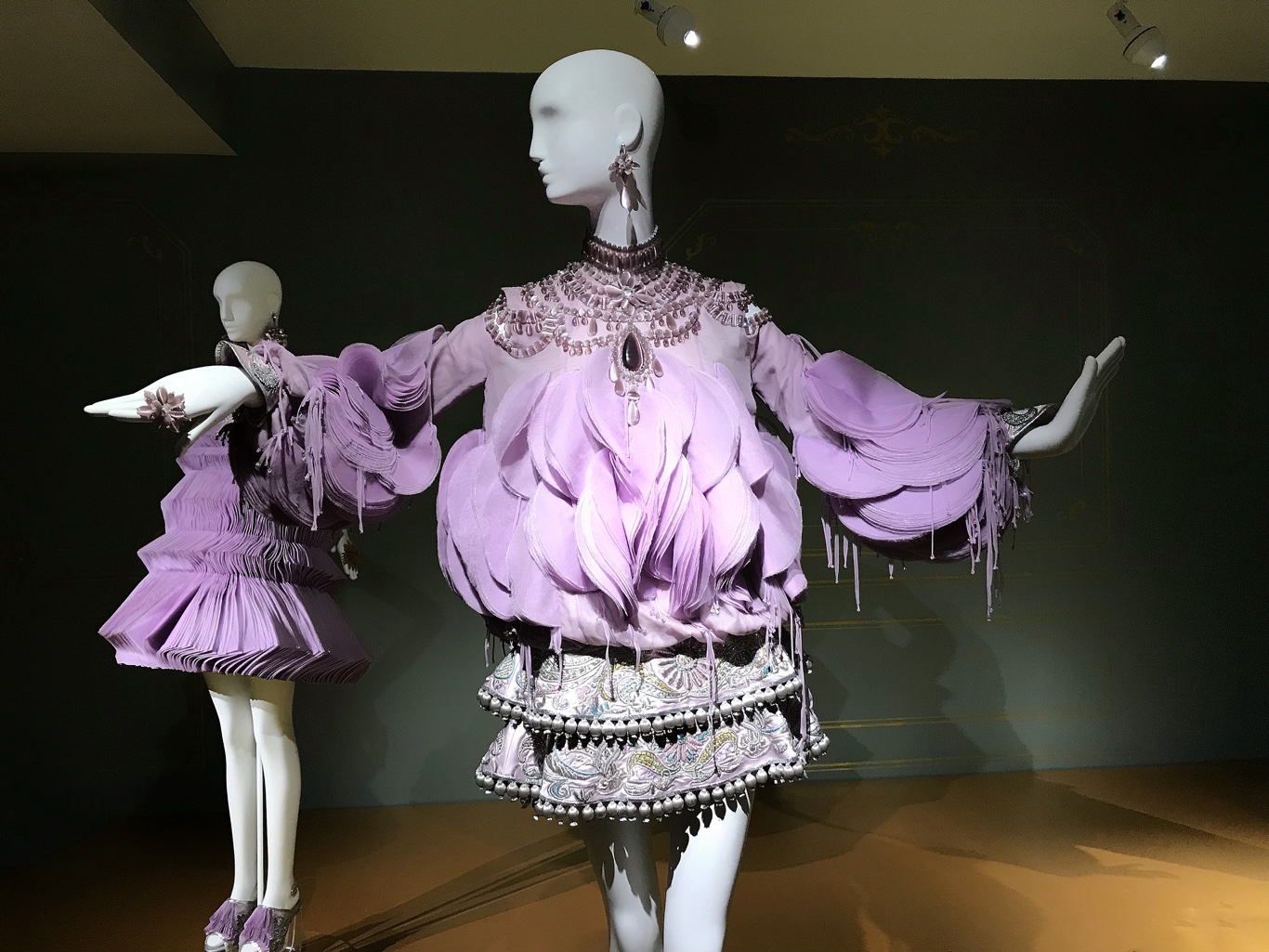
“Fashion shouldn’t just be about the present. I care more about the meaning behind the details. Therefore, the embroidery and motifs you see on my clothing all have stories behind them.”
GUO PEI, 2018
My membership for the Vancouver Art Gallery has come up for renewal according to an e-mail that I received a few days ago. Vancouver has enjoyed many excellent exhibitions over the years thanks to Vancouver Art Gallery’s professional team. During the past year of lockdown, everyone at the Gallery worked tirelessly to foster creativity during a time of uncertainty.

Tonight, I am going back to the exhibition, Guo Pei: Couture Beyond to share an unforgettable exhibition. Guo Pei is a storyteller, first and foremost. Her stories are not given with words that are written with pen and paper. They are created with the artistic energy and flare of embroidery and bead-work that adorns her exquisite couture collections.

From the exhibition notes:
By 1881 there were 1,050 people-primarily young girls-in the East China city of Suzhou alone engaged in embroidery. However, in 1997, when Guo Pei set off to open her own atelier, Rose Studio in Beijing, she struggled to find skilled embroiderers able to bring her creations to life. Embroidery and cotton cloth weaving in China was historically done by women at home, and provided an integral income for sustaining their families.

Guo Pei had heard that in the Hubei province there remained a group of craftspeople who had embroidered for the royal family, and so she journeyed to central China knocking on the doors of homes with embroidered curtains. With the aid of the women she met there, Guo Pei trained a new generation of embroiderers and has built an atelier that employs more than 500 workers including skilled artisans and technicians. Together, they produce three to four thousand custom garments each year.
Many of Guo Pei’s designs incorporate ancient yet familiar Chinese motifs, such as the lotus which represents purity of mind and spirit; ruyi embodied by the head of a scepter, symbolizing the power to grant wishes; the mountain and wave which were commonly used on the hems of royal court robes and the meander or cloud and thunder pattern which represents rain and abundance-some of these can be seen in her sketches, which are displayed here.

However, Guo Pei has said that her favourite motif is the dragon, which was historically reserved for the Emperors robes, distinguished by five toes rather than the four found in its depiction on common goods. As a child, Guo Pei’s grandmother would recount her memories of the extravagant gowns embroidered with butterflies and peonies that women wore in the final years of the Qing Empire, China’s last imperial dynasty (1644-1912). Guo Pei, born in 1967 during the height of China’s Cultural Revolution, could scarcely imagine such lavish attire at a time when the rough cotton, utilitarian Mao suit was the height of fashion.
For more photos of this exhibition, I invite you to visit my SmugMug page entitled: Guo Pei Beyond Couture



Beautiful art!
LikeLiked by 1 person
Thank you for stopping by, Cindy. Guo Pei brought back an ancient craft and shared it with the world. A generous gift!!!
LikeLike
Oh that was beautiful. How wonderful to have been able to see it.
LikeLiked by 1 person
I am delighted to you joined me at the Vancouver Art Gallery Shehanne. Isn’t it fun to go back in time! What was extraordinary about Guo Pei was her commitment to bring back an ancient craft that was nearing extinction. Now, there is an industry to employs many women who are able to express their creativity as make a living at the same time. It is a win-win outcome for art and society. Sending hugs along with my thanks!!!
LikeLiked by 2 people
I saw that and I thought that. So she is also saving all that history, skill, beauty and tradition. xxxxxx
LikeLiked by 2 people
I was also reminded of how my mum and dad who were in Hongkong..then leased elsewhere.. after WW2 talked about the women and children they saw sitting on kerbs and in alleyways, doing the most beautiful embroidery x
LikeLiked by 2 people
What a wonderful memory.
LikeLiked by 1 person
This are realy unseen pieces of artwork !
LikeLiked by 1 person
Thank you so much for stopping by and viewing Guo Pei’s amazing creativity. Have a wonderful day.
LikeLike
I really love this presentation about embroidery, Rebecca, and here the Chinese one in particular. It is just absolutely gorgeous, but I am also very interested in China and its history! At the moment I am reading and preparing a post which touches also the Qing dynasty! Besides, I would like to say that in the region of Switzerland, where I come from, embroidery was highly developed and my mother in law did it at home to earn a little bit of money! I add a link of the museum. https://artsandculture.google.com/exhibit/st-galler-stickereien-textilmuseum-st-gallen/_gJSmVU5bjsbLQ?hl=de
LikeLiked by 3 people
I am delighted that you joined me at the Vancouver Art Gallery. I look forward to your post that touches on the Qing dynasty. It was a time of incredible change and transition. I have a few pieces of my Grandmother’s embroidery that I keep safely tucked away in a drawer. I marvel at the intricacies of the craft. I just looked up embroidery in Switzerland and found that St. Gallen embroidery is also known as Swiss embroidery. In the early 1900’s, the embroidery production in this region was the largest export branch of the Swiss economy with 18% of the overall export value. I did not know this, Martina. Thank you so much for this information. I’m very interested is pursuing more research on this subject.
LikeLiked by 3 people
Embroidery is a big and wonderful topic, but in our part also a difficult one, because with the outbreak of the first world war the demand for this luxurious product collapsed and many people lost their jobs! It was a pleasure, Rebecca, to look into this “art” together with you!
LikeLiked by 2 people
Excellent. I am hardly a fashionista- unless you include Hobo Couture- but I do like costumes that excite the imagination. These look like things from science fiction moviews and illustrated fairy story books. Lovely, just the ticket!
LikeLiked by 3 people
I knew that you would enjoy Guo Pei, Paul. I was not surprised that Guo Pei’s favourite mythology was about dragons. Every collection had a story. For example, her Samsara collection (2006) was based on the Sanskrit term Samsara which refers to the continuous cycle of life, death and reincarnation. Thank you for joining me at the Vancouver Art Galley. And just think – no jet lag in the travel.
LikeLiked by 3 people
Oh so elegant and definitely exquisite workmanship. The embroidery is really intricate and each garment must take so much time to make. No wonder her clothes are so expensive.
LikeLiked by 3 people
Can you imagine the amount of hours it takes to make a dress?! YIKES! I was amazed that as a young woman, Guo Pei envisioned a rebirth of an ancient craft, especially at a time when China was in transition. To find artists by looking at window curtains that were embroidered was a brilliant idea. Fashion speaks to a story of a society. Even the investment bankers have to admit that fashion influences trade, banking, employment figures etc. I’m delighted that you joined me at the Vancouver Art Galley. Sending many hugs your way. Welcome to a new week of possibilities.
LikeLiked by 3 people
These gowns are exquisite, Rebecca. I was interested in the fact that Guo Pei struggled to find women who could do this sort of traditional embroidery. We have the same thing here in South Africa. The younger women are not interested in learning any of their cultural artwork methodologies and the skills are being lost. It is a shame. The elderly women do the most lovely crocheting.
LikeLiked by 2 people
I agree, Robbie – cultural heritage is so important to a society. We don’t realize that traditions are easily lost with the passing of generations. My grandmother tried to teach me tatting, but alas my fingers didn’t have the patience to learn the intricate steps. As a child, I would accompany my grandmother when she went to the Ladies Aid meetings. There was such a lovely feeling watching the women work together on a quilt, have tea and cookies and talk about all the comings and goings of the communities.
LikeLiked by 2 people
How wonderfully fascinating. I found myself enlarging the photos to see the detail and am left wondering how she actually did it! Thank you, I fully enjoyed it!
LikeLiked by 2 people
Frances and Sarah, who have experience with embroidery, joined me at the exhibition. Like you, they marveled at the detail and intricate beading, silk threads and linkages. I can’t even imagine the hours that went into each gown. So glad that you enjoyed the exhibition with me. Sending hugs!!!
LikeLiked by 1 person
Absolutely magnificent designer. Memories of my dear mother, who spent the better part of her life in a like career starting back in the mid 1940s.
LikeLiked by 2 people
I am delighted that you joined me at the Vancouver Art Gallery. I knew that your would enjoy this collection/exhibition. Thank you for joining me, Jean-Jacques!!!
LikeLike
Thank you, Rebecca for this lovely memory–we enjoyed a tour sometime ago. This is one of the hundreds of experiences that we have had together. I remember all the expertly designed dresses and I wondered at the time (and still wonder) how anyone could wear and be comfortable wearing all the many yards of fabric with all the extravagant designs, beads, lace and ribbon added to it. I recall our time together with importance and love. Thank you for sharing this!
LikeLiked by 2 people
I found some interesting information on the “yellow” gown: “The now-famous Yellow Empress cape weighs 25kg, has a 16ft train, features over 50,000 hour’s worth of hand embroidery and took two years to make. The sheer weight of the dress meant that, when it was first shown, at a 2012 show in China, the model made it only halfway down the catwalk before the lights had to be turned off and the show stopped so that she could remove the cape and return backstage.” https://www.theguardian.com/fashion/2017/oct/18/guo-pei-chinese-designer-who-made-rihanna-omelette-dress. The article goes on to say: “Rihanna managed to pull it off, though, literally and figuratively. “Rihanna wearing my design had a great impact – and the international fashion industry gained a new understanding of me,” says Guo”. I agree Frances, we have had many adventures and there are more to come.
LikeLiked by 1 person
💕🦋🌷⚘🌹💕
LikeLiked by 1 person
This added onfo information is interesting. I am not surprised that the one wearing the dress only made it half way around! But, so beautiful.
LikeLiked by 1 person
It’s hard to believe all of that rich, layered, and intricate embroidery was done by hand. The pieces in the collection look like textile sculptures, rather than clothing. I’ve always found couture a bit confounding.
LikeLiked by 1 person
So, so gorgeous.
LikeLiked by 1 person
I agree, Julie. So much work and effort went into each creation. I envision a group working together to bring out the design – a rewarding experience to participate in this labor of love.
LikeLiked by 1 person
Brilliant and beautiful!
Although of a complete different philosophy behind what we use to create, I completely agree with her; “Fashion shouldn’t just be about the present. I care more about the meaning behind the details.”
Although, (for my ends) I would rewrite the second part of the quote; “Therefore, the embroidery and motifs you see on my clothing all have stories behind them.”
TO;
Therefore all of the recycled, up-cycled, repurposed items, chintzy goods and fabrics that end up in land fills & that wind up in my gowns have stories behind them. One of those stories is one less piece of garbage in the dump.
Rebecca, I’ve got people saving the plastic mesh produce bags from onions, lemons, avocados, etc. for me. You know I can’t bear to see another pic of a bird with its beak caught in one of those mesh bags. They end up starving to death.
I will make an Art Gown from those.
Pre Covid, I was working on some kind of art show with the Art Gowns, and my Gown Art. The art supplies shops will be opening soon, and I will get more canvases.
Covid can’t last forever. I’ve got 10 Art Gowns that can be put on models, #11 is 8 hours away from being finished.
This article has been inspiring to me, in many ways. Thank you!
LikeLiked by 1 person
This is the most excellent comment, Resa. I am beyond excited by your idea on plastic mesh turned into glamorous gowns. You are AMAZING!!!!
LikeLike